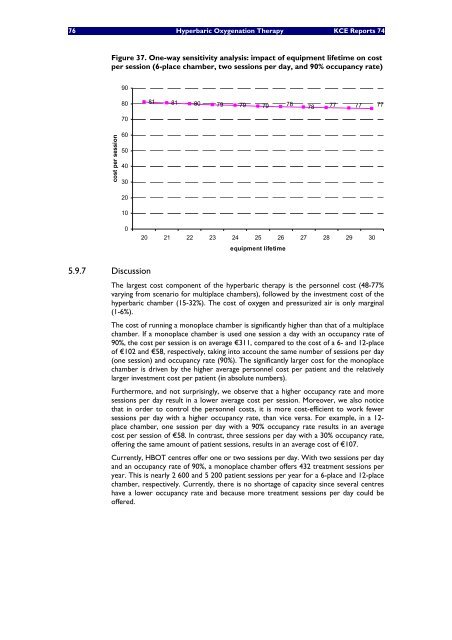Hyperbare Zuurstoftherapie: Rapid Assessment - KCE
Hyperbare Zuurstoftherapie: Rapid Assessment - KCE
Hyperbare Zuurstoftherapie: Rapid Assessment - KCE
You also want an ePaper? Increase the reach of your titles
YUMPU automatically turns print PDFs into web optimized ePapers that Google loves.
76 Hyperbaric Oxygenation Therapy <strong>KCE</strong> Reports 74<br />
Figure 37. One-way sensitivity analysis: impact of equipment lifetime on cost<br />
per session (6-place chamber, two sessions per day, and 90% occupancy rate)<br />
cost per session<br />
90<br />
80<br />
70<br />
60<br />
50<br />
40<br />
30<br />
20<br />
10<br />
5.9.7 Discussion<br />
0<br />
81 81 80 79 79 79 78<br />
78 77 77 77<br />
20 21 22 23 24 25 26 27 28 29 30<br />
equipment lifetime<br />
The largest cost component of the hyperbaric therapy is the personnel cost (48-77%<br />
varying from scenario for multiplace chambers), followed by the investment cost of the<br />
hyperbaric chamber (15-32%). The cost of oxygen and pressurized air is only marginal<br />
(1-6%).<br />
The cost of running a monoplace chamber is significantly higher than that of a multiplace<br />
chamber. If a monoplace chamber is used one session a day with an occupancy rate of<br />
90%, the cost per session is on average €311, compared to the cost of a 6- and 12-place<br />
of €102 and €58, respectively, taking into account the same number of sessions per day<br />
(one session) and occupancy rate (90%). The significantly larger cost for the monoplace<br />
chamber is driven by the higher average personnel cost per patient and the relatively<br />
larger investment cost per patient (in absolute numbers).<br />
Furthermore, and not surprisingly, we observe that a higher occupancy rate and more<br />
sessions per day result in a lower average cost per session. Moreover, we also notice<br />
that in order to control the personnel costs, it is more cost-efficient to work fewer<br />
sessions per day with a higher occupancy rate, than vice versa. For example, in a 12place<br />
chamber, one session per day with a 90% occupancy rate results in an average<br />
cost per session of €58. In contrast, three sessions per day with a 30% occupancy rate,<br />
offering the same amount of patient sessions, results in an average cost of €107.<br />
Currently, HBOT centres offer one or two sessions per day. With two sessions per day<br />
and an occupancy rate of 90%, a monoplace chamber offers 432 treatment sessions per<br />
year. This is nearly 2 600 and 5 200 patient sessions per year for a 6-place and 12-place<br />
chamber, respectively. Currently, there is no shortage of capacity since several centres<br />
have a lower occupancy rate and because more treatment sessions per day could be<br />
offered.

















